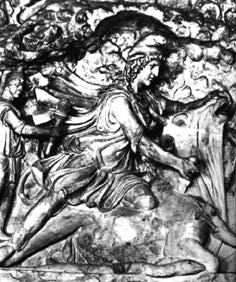|
|
The Mithraic Cult |
|
 If you've found this site useful, we'd really appreciate a small donation to help with the hosting costs. Thanks! |
Picasso's use of the bullfight theme appears to have an association with the Mithraic cult. The American art historian Ruth Kaufman identified the use of Mithraic iconography in Picasso's Crucifixion of 1930 and associated it with the writings of Georges Bataille who was Picasso's friend at that time.
The Mithraic cult was early Christianity's most serious rival as it spread from Syria, Anatolia and Phrygia throughout the Roman Empire. Its origins are obscure but it was known to have been one of the religions of ancient Indo-Persia. The earliest record of the cult dates as far back as 1400 B.C. The cult was a form of sun worship involving astrology. Its was symbolically represented by the god Mithras and the eternal struggle between good and evil. It was an exclusive male cult with seven grades of initiation, symbolized by a seven runged ladder which was believed to lead to immortality. Most important in the stages of initiation was the slaying of the bull, a re-enactment of Mithras' killing of the cosmic bull of creation, symbolising the conquest of evil and death. The Mithraic cap represented freedom from materialism and another of its symbols, the Tau cross, signified the uniting of opposites. The cult was introduced to the West in the 1st century AD by the Romans and it became very popular among the military and the merchant classes. By the 4th century, it became the target of Christian persecution and gradually died out, but its legacy continued to live on in the more secretive practices of Alchemy. Symbolic facets of the legacy also found their way into Christianity, Mithras' birth was celebrated on the 25th of December, and cakes marked with a cross, representing the Earth, were traditionally eaten at the cult meal. The 1934 drawing is full of Mithraic symbolism derived from the traditions of alchemy and the artists knowledge of ancient culture and symbolism. The theme of the bullfight is partly a Mithraic theme. Picasso's use of the seven runged ladder and the Tau cross in the drawing appear to be derived from the same source, as are a number of other more obsure symbols. The symbolism of Mithraism was extensive and parts of it correspond astonishingly with other esoteric disciplines including the Kabbala and the Tarot.
© Mark Harris 1996 Alchemical ContextsNext Section: Interpretations of the 1934 Drawing |
|
|
|
     |
     |
|
|
© Mark Harris 1996 (content), Simon Banton 1996 (design) In general copyright of works by Pablo Picasso are the property of the heirs to the Pablo Picasso estate |
|

 Picasso also seems to have referred to the Mithraic cult in his work before 1930. In 1901, he made a series of studies and paintings of women at the infirmary of Saint Lazare, in which the subjects are often wearing a Mithraic cap, a kind of bonnet traditionally worn by Mithras and associated with alchemy. The patients at Saint Lazare wore a similar type of headgear; Picasso's exaggerated rendition of it has been linked to the Phrygian cap - the Mithraic cap by another name, which later became a symbol of the French revolution.
Picasso also seems to have referred to the Mithraic cult in his work before 1930. In 1901, he made a series of studies and paintings of women at the infirmary of Saint Lazare, in which the subjects are often wearing a Mithraic cap, a kind of bonnet traditionally worn by Mithras and associated with alchemy. The patients at Saint Lazare wore a similar type of headgear; Picasso's exaggerated rendition of it has been linked to the Phrygian cap - the Mithraic cap by another name, which later became a symbol of the French revolution.